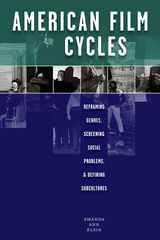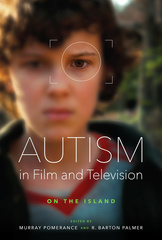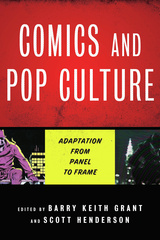Cycles, Sequels, Spin-offs, Remakes, and Reboots
Multiplicities in Film and Television
With sequels, prequels, remakes, spin-offs, or copies of successful films or franchises dominating film and television production, it sometimes seems as if Hollywood is incapable of making an original film or TV show. These textual pluralities or multiplicities—while loved by fans who flock to them in droves—tend to be dismissed by critics and scholars as markers of the death of high culture. Cycles, Sequels, Spin-offs, Remakes, and Reboots takes the opposite view, surveying a wide range of international media multiplicities for the first time to elucidate their importance for audiences, industrial practices, and popular culture.
The essays in this volume offer a broad picture of the ways in which cinema and television have used multiplicities to streamline the production process, and to capitalize on and exploit viewer interest in previously successful and/or sensational story properties. An impressive lineup of established and emerging scholars talk seriously about forms of multiplicity that are rarely discussed as such, including direct-to-DVD films made in Nigeria, cross-cultural Japanese horror remakes, YouTube fan-generated trailer mash-ups, and 1970s animal revenge films. They show how considering the particular bonds that tie texts to one another allows us to understand more about the audiences for these texts and why they crave a version of the same story (or character or subject) over and over again. These findings demonstrate that, far from being lowbrow art, multiplicities are actually doing important cultural work that is very worthy of serious study.
This volume expands on Amanda Ann Klein’s American Film Cycles to open up an extremely fruitful approach to serial and related media phenomena. It will no doubt be adopted as a supplementary text for a wide range of courses in film and television studies.
A strong and very necessary addition to the growing body of work that contends with filmic repetition and the commercial and cultural complexities of film and television production and reception across multimedia platforms. The range of essays is impressive.
- Acknowledgments
- Chapter 1. Introduction (Amanda Ann Klein and R. Barton Palmer)
- Chapter 2. The Kissing Cycle, Mashers, and (White) Women in the American City (Amanda Ann Klein)
- Chapter 3. Descended from Hercules: Masculine Anxiety in the Peplum (Robert Rushing)
- Chapter 4. The American Postwar Semidocumentary Cycle: Factual Dramatizations (R. Barton Palmer)
- Chapter 5. Cycle Consciousness and the White Audience in Black Film Writing: The 1949–1950 "Race Problem" Cycle and the African American Press (Steven Doles)
- Chapter 6. Vicious Cycle: Jaws and Revenge-of-Nature Films of the 1970s (Constantine Verevis)
- Chapter 7. Familiar Otherness: On the Contemporary Cross-Cultural Remake (Chelsey Crawford)
- Chapter 8. Anime's Dangerous Innocents: Millennial Anxieties, Gender Crises, and the Shōjo Body as a Weapon (Elizabeth Birmingham)
- Chapter 9. It's Only a Film, Isn't It? Policy Paranoia Thrillers of the War on Terror (Vincent M. Gaine)
- Chapter 10. Doing Dumbledore: Actor-Character Bonding and Accretionary Performance (Murray Pomerance)
- Chapter 11. A Lagosian Lady Gaga: Cross-Cultural Identification in Nollywood's Anti-Biopic Cycle (Noah Tsika)
- Chapter 12. Re-solving Crimes: A Cycle of TV Detective Partnerships (Sarah Kornfield)
- Chapter 13. Smart TV: Showtime's "Bad Mommies" Cycle (Claire Perkins)
- Chapter 14. My Generation(s): Cycles, Branding, and Renewal in E4's Skins (Faye Woods)
- Chapter 15. Extended Attractions: Recut Trailers, Film Promotion, and Audience Desire (Kathleen Williams)
- Chapter 16. Retro-Remaking: The 1980s Film Cycle in Contemporary Hollywood Cinema (Kathleen Loock)
- Chapter 17. I Can't Lead This Vacation Anymore: Mumblecore's American Man (Amy Borden)
- Chapter 18. Serialized Killers: Prebooting Horror in Bates Motel and Hannibal (Andrew Scahill)
- List of Contributors
- Index








